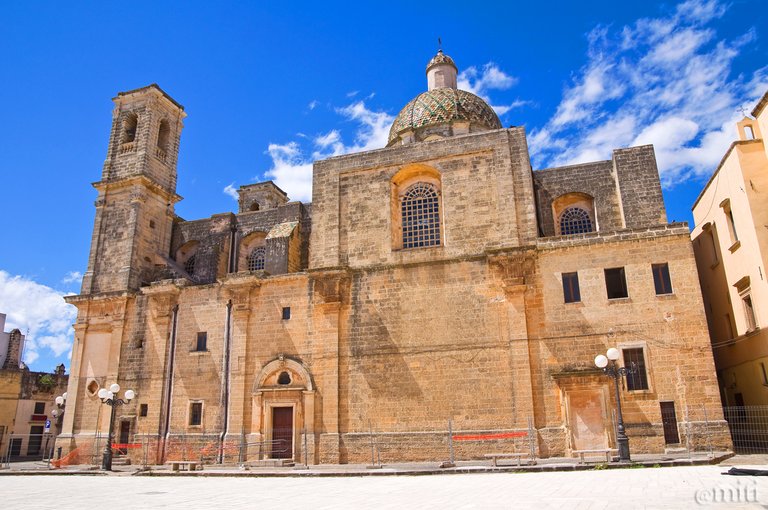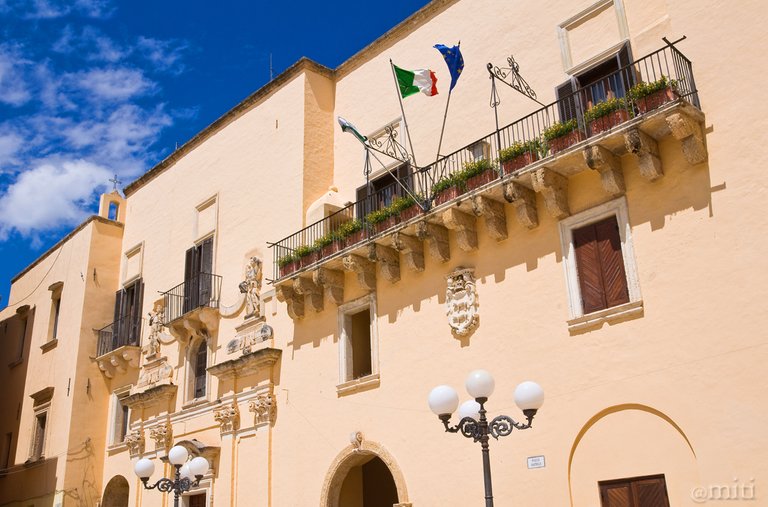
The Church of the Transfiguration of Our Lord Jesus Christ (Author's photo - All rights reserved)
La Chiesa della Trasfigurazione di Nostro Signore Gesù Cristo (Immagine dell'autore - tutti i diritti sono riservati)



Ciao a tutti,
questo è un viaggio attraverso l'Italia. Posterò una foto al giorno con una brevissima descrizione. Spero vi piaccia!

Taurisano è un piccolo borgo della provincia di Lecce, nella regione italiana meridionale della Puglia. Il suo territorio è ricco di reperti archeologici come oggetti e monumenti megalitici.
La città prende il nome probabilmente dal toro che risalta sul suo stemma. Potrebbe anche essere chiamata così in onore del centurione romano Taurisianus il quale ricevette il centro come ricompensa per il coraggio dimostrato in battaglia.
I primi documenti storici risalgono al 12 ° secolo. Da questo documento apprendiamo che Tancredi D'Altavilla lasciò il feudo a Filiberto Monteroni che divenne il primo feudatario nel 1191. Agli inizi del XIII secolo, però, ai Normanni subentrarono gli Svevi con Federico II che donò il principato di Taranto, di cui faceva parte anche Taurisano, al figlio Manfredi.
Successivamente passò alle famiglie D'Angiò, poi a Monteronis a Carlo V che lo cedette ai Gattinara e poi ancora a De Castro e infine a Bartolomeo Lopez e Royo. Questa fu l'ultima famiglia a governare il villaggio perché nel 1806 il sistema feudale fu soppresso.
Il centro storico conserva chiese e palazzi interessanti. Tra tutti spicca il Palazzo Ducale, costruito sulle fondamenta di un antico castello angioino e che oggi ospita gli uffici del Municipio.
Dell'antico complesso sono conservati un arco romanico sulla facciata ovest e una torre costruita nel XIII secolo dai signori feudali Gattinara Lignani.
La Chiesa della Trasfigurazione di Nostro Signore Gesù Cristo fu costruita tra il 1803 e il 1820 per sostituire un altro tempio sacro del sedicesimo secolo. In origine, il sito dell'attuale chiesa era occupato da un edificio della seconda metà del XIII secolo, dedicato a San Salvatore, che doveva costruire la Cappella Palatina del castello. La facciata, tra due campanili, si sviluppa in due ordini di pilastri. Sull'architrave della porta d'ingresso è posto lo stemma di Taurisano.
La Chiesa di San Nicola o Nostra Signora della Consolazione è stata costruita nel 1733 da Bartolomeo Lopez e Royo ed è accorpata nel Palazzo Ducale, che in passato ha nominato cappella. La facciata, inserita nel prospetto del palazzo, è scandita da due ordini di lesene con capitelli corinzi. Al centro si apre il portale d'ingresso, sul cui architrave è inserito una lapide con un’incisione. Completano la facciata due altorilievi raffiguranti gli arcangeli Michele e Raffaele.
Nella campagna circostante i visitatori possono scoprire monumenti antichi, come i menhir Sajetti e Specchia Silvia che rappresentano la testimonianza storica più antica che è rimasta invariata nel tempo.
Specchia Silva è un grande tumulo di pietre alte 10 metri. Gli studiosi affermano che fino alla fine del XIX secolo era tre volte più alto. Le pietre che lo formano sono state infatti utilizzate per produrre calce. La specchia era probabilmente una vedetta di un'area più vasta.
Un'altra antica testimonianza di pietra è il Menhir Sajetti, di cui è visibile solo la parte superiore, con una croce e un foro nella parte superiore. Fu scoperto negli anni '80 in contrada Saglietti e poi spostato all'interno del cortile della scuola media della città.
Tra i personaggi famosi nati a Taurisano possiamo ricordare Giulio Cesare Vanini che nacque nel 1875.
Cosa vedere: il Centro storico, il Palazzo Ducale, la Chiesa della Trasfigurazione di Nostro Signore Gesù Cristo, la Chiesa di San Nicola (o Nostra Signora della Consolazione), la Chiesa di Santa Maria della Strada, la Chiesa di Santo Stefano, Specchia Silva e Menhir Sajetti.

Hello everyone,
I began a Photo Journey through Italy. I will post one photo every day with a little note of explanation. I hope you like it!

Taurisano is a small town in the province of Lecce, in the southern Italian region of Puglia. Its terrytory is rich in archaeological finds such as megalithic objects and monuments.
The town takes its name probably from the bull that stands out the coat of arms. It could also be named after the Roman centurion Taurisianus who was given the town for his victories in the war.
The first historic documents date to the 12th century. From this document we learn that Tancredi D’Altavilla left the feud to Filiberto Monteroni who became the first feudatory in 1191. At the beginnings of the 13th century the Swabian Federico II took the place of the Normans. He gave the Princedom of Taranto (including Taurisano) to his son Manfredi.
Subsequently, it passed to the families D’Angiò, Monteronis then to Carlo V who gave it to the Gattinaras and then again De Castro and finally Bartolomeo Lopez y Royo. This was the last family to rule the village because in 1806 the feudal system was suppressed.
The old town preserves churches and palaces. Among all stands out the Ducal Palace, built on the foundations of an ancient Angevin castle and now houses the offices of the Town Hall.
Of the ancient complex are kept a Romanesque arch on the west facade and a tower built in the thirteenth century by the feudal lords Gattinara Lignans.
The Church of the Transfiguration of Our Lord Jesus Christ was built between 1803 and 1820 to replace another sixteenth-century sacred temple. Originally, the site of the present church was occupied by a building of the second half of the XIII century, dedicated to San Salvatore, which was to form the Palatine Chapel of the castle. The façade, between two bell towers, it develops into two orders pilasters. On the lintel of the front door is placed the coat of arms of Taurisano.
The St. Nicholas Church or Our Lady of Consolation was built in 1733 by Bartolomeo Lopez y Royo and is merged to the Ducal Palace, which in the past he appointed chapel. The facade, inserted into the building elevation, is marked by two orders of pilasters with Corinthian capitals. At the centre of the entrance portal opens, on whose lintel a tombstone with an incision is inserted. Completing the front two reliefs depicting the archangels Michael and Raphael.
In the surrounding countryside visitors can discover ancient monuments, such as the menhir Sajetti and Specchia Silvia which represent the most ancient historical evidence which has been unchanged over the time.
Specchia Silva is a large mound of stones, 10 metres high. The scholars say that until the end of the 19th century was three times higher. The stones which form it were indeed used to produce lime. The specchia was probably a lookout of a larger area.
Another ancient evidence of stone is the Menhir Sajetti, of which only the upper part is still visible, with a cross and a hole at the top. It was discovered in the 80s in contrada Saglietti and then moved inside the courtyard of the middle school of the town.
Among the famous people born in Taurisano we can remember Giulio Cesare Vanini was born in 1875.
Thing to see: the Historical centre, the Ducal Palace, the Church of the Transfiguration of Our Lord Jesus Christ, The St. Nicholas Church (or Our Lady of Consolation), the Church of the Blessed Virgin Mary of the Way, the Church of Saint Stephen, the Specchia Silva and Menhir Sajetti.

| Tipo di foto / Category | Paesaggio / Landscape view |
| Esposizione / Settings | 1/320 sec, ISO 200, f/10 |
| Camera | Nikon D5000 |
| Lente / Lens | Tamron SP 17-50mm f/2.8 XR Di II LD |
| Filtro / Filter | Polarizzatore Hoya / Hoya Polarizing filter |
| Cavalletto / Tripod | Manfrotto MKC3-P01 |
| Località / Location | Taurisano (Lecce), Italia |
| Software | Photoshop |


The Ducal Palace (Author's photo - All rights reserved)
Il Palazzo Ducale (Immagine dell'autore - tutti i diritti sono riservati)
i enjoy youer posts
Che bel posto anche questo! :-)))
Congratulations, Your Post Has Been Added To The Steemit Worldmap!
Author link: http://steemitworldmap.com?author=mitiPost link: http://steemitworldmap.com?post=a-journey-through-italy-one-photo-every-day-132-taurisano-eng-ita
Want to have your post on the map too?
Wow.It is a beautiful photo.
Very Nice picture
Thanks.
Excellent publication, very nice photos and very well explained.
I'm glad you like it!
You are 100% qualified professional photographer, well done @miti
Thank you.
@miti Its beautiful Church.I love your photography.keep sharing.
I'll do it.
Hi,
The pictures are very beautifully taken and looking very natural. And I personally appreciate you for regularly letting us know about different historical places and information related to them.
Only few people have this habit of posting historical events and updates. You are one of them.
Please do post such articles on regular basis. I already started follow you.
Thank you for your kind words!
Excellent bro how u collect so many upvote. Congrulation
Congrats to your nice pictures ;-)
;-)
BEAUTIFUL BEAUTIFUL SHOTS!!
IS A COUNTRY THAT I REALLY WANT TO VISIT SOME DAY.
CONTINUE SHOWING YOUR ADVENTURES IN ITALY.
Italy is a very beatiful and romantic country! I love traveling there!
You got a 43.18% upvote from @ocdb courtesy of @miti!